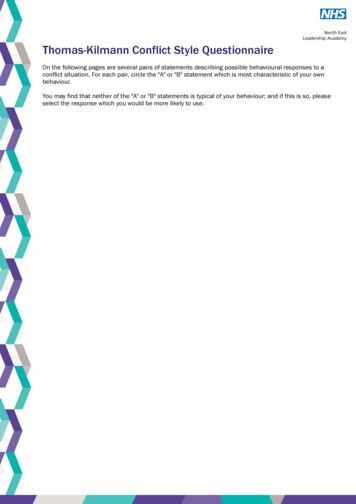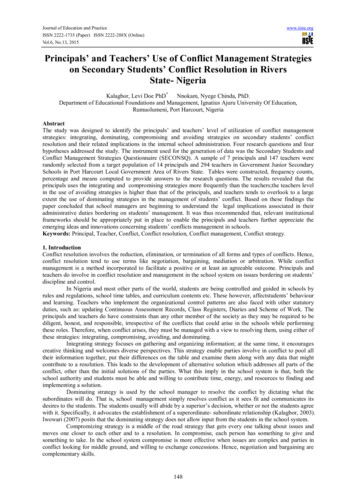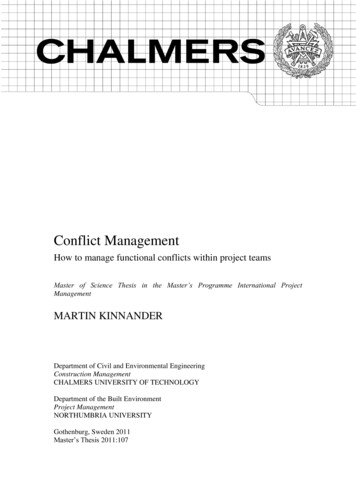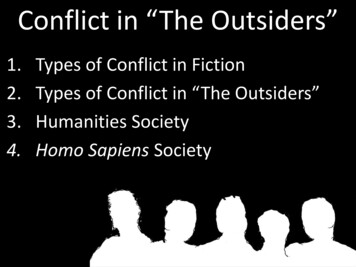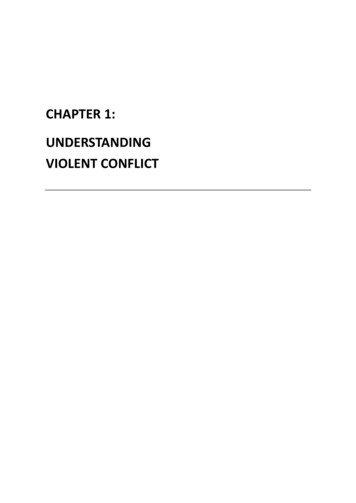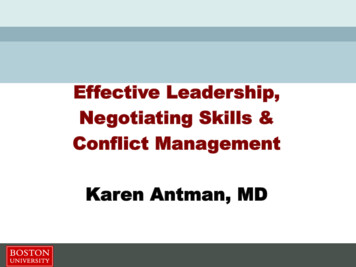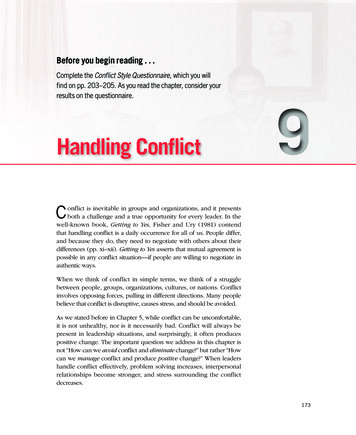
Transcription
Before you begin reading . . .Complete the Conflict Style Questionnaire, which you willfind on pp. 203–205. As you read the chapter, consider yourresults on the questionnaire.Handling Conflict9Conflict is inevitable in groups and organizations, and it presentsboth a challenge and a true opportunity for every leader. In thewell-known book, Getting to Yes, Fisher and Ury (1981) contendthat handling conflict is a daily occurrence for all of us. People differ,and because they do, they need to negotiate with others about theirdifferences (pp. xi–xii). Getting to Yes asserts that mutual agreement ispossible in any conflict situation—if people are willing to negotiate inauthentic ways.When we think of conflict in simple terms, we think of a strugglebetween people, groups, organizations, cultures, or nations. Conflictinvolves opposing forces, pulling in different directions. Many peoplebelieve that conflict is disruptive, causes stress, and should be avoided.As we stated before in Chapter 5, while conflict can be uncomfortable,it is not unhealthy, nor is it necessarily bad. Conflict will always bepresent in leadership situations, and surprisingly, it often producespositive change. The important question we address in this chapter isnot “How can we avoid conflict and eliminate change?” but rather “Howcan we manage conflict and produce positive change?” When leadershandle conflict effectively, problem solving increases, interpersonalrelationships become stronger, and stress surrounding the conflictdecreases.173
174INTRODUCTION TO LEADERSHIPCommunication plays a central role in handling conflict. Conflict is aninteractive process between two or more parties that requires effectivehuman interaction. By communicating effectively, leaders and followerscan successfully resolve conflicts to bring positive results.This chapter will emphasize ways to handle conflict. First, we will defineconflict and describe the role communication plays in conflict. Next, wewill discuss different kinds of conflict, followed by an exploration ofFisher and Ury’s (1981) ideas about effective negotiation as well as othercommunication strategies that help resolve conflict. The final part of thechapter examines styles of approaching conflict and the pros and consof these styles.CONFLICT DEFINEDConflict has been studied from multiple perspectives, includingintrapersonal, interpersonal, and societal. Intrapersonal conflict refersto the discord that occurs within an individual. It is often studied bypsychologists and personality theorists who are interested in thedynamics of personality and factors that predispose people to innerconflicts. Interpersonal conflict refers to the disputes that arise betweenindividuals. This is the type of conflict we focus on when we discussconflict in organizations. Societal conflict refers to clashes betweensocieties and nations. Studies in this field focus on the causes ofinternational conflicts, war, and peace. The continuing crisis betweenthe Israelis and the Palestinians is a good example of social conflict.This chapter focuses on conflict as an interpersonal process that plays acritical role in effective leadership.The following definition, based on the work of Wilmot and Hocker(2011, p. 11) best describes conflict. Conflict is a felt struggle betweentwo or more interdependent individuals over perceived incompatibledifferences in beliefs, values, and goals, or over differences in desires foresteem, control, and connectedness. This definition emphasizes severalunique aspects of conflict (Wilmot & Hocker, 2011).Journal Link 9.1Read more aboutintrapersonalconflict.First, conflict is a struggle; it is the result of opposing forces comingtogether. For example, there is conflict when a leader and a senior-levelemployee oppose each other on whether or not all employees mustwork on weekends. Similarly, conflict occurs when a school principaland a parent disagree on the type of sex education program that
Chapter 9 Handling Conflict175should be adopted in a school system. In short, conflict involves a clashbetween opposing parties.Second, there needs to be an element of interdependence betweenparties for conflict to take place. If leaders could function entirelyindependently of each other and their subordinates, there would beno reason for conflict. Everyone could do their own work, and therewould be no areas of contention. However, leaders do not work inisolation. Leaders need followers, and followers need leaders. Thisinterdependence sets up an environment in which conflict is morelikely.When two parties are interdependent, they are forced to deal withquestions such as “How much influence do I want in this relationship?”and “How much influence am I willing to accept from the other party?”Because of our interdependence, questions such as these cannotbe avoided. In fact, Wilmot and Hocker (2011) contend that thesequestions permeate most conflicts.Third, conflict always contains an affective element, the “felt” part of thedefinition. Conflict is an emotional process that involves the arousal offeelings in both parties of the conflict (Brown & Keller, 1979). Whenour beliefs or values on a highly charged issue (e.g., the right to strike)are challenged, we become upset and feel it is important to defendour position. When our feelings clash with others’ feelings, we are inconflict.The primary emotions connected with conflict are not always anger orhostility. Rather, an array of emotions can accompany conflict. Hockerand Wilmot (1995) found that many people report feeling lonely, sad,or disconnected during conflict. For some, interpersonal conflict createsfeelings of abandonment—that their human bond to others has beenbroken. Feelings such as these often produce the discomfort thatsurrounds conflict.Fourth, conflict involves differences between individuals that areperceived to be incompatible. Conflict can result from differences inindividuals’ beliefs, values, and goals, or from differences in individuals’desires for control, status, and connectedness. The opportunities forconflict are endless because each of us is unique with particular sets ofinterests and ideas. These differences are a constant breeding groundfor conflict.Video Link 9.1 atch suggestionsWfor ending conflict.
176INTRODUCTION TO LEADERSHIPIn summary, these four elements—struggle, interdependence, feelings,and differences—are critical ingredients of interpersonal conflict. Tofurther understand the intricacies of managing conflict, we’ll look atthe role of communication in conflict and examine two major kinds ofconflict.COMMUNICATION AND CONFLICTWhen conflict exists in leadership situations, it is recognized andexpressed through communication. Communication is the meansthat people use to express their disagreements or differences.Communication also provides the avenue by which conflictscan be successfully resolved, or worsened, producing negativeresults.Journal Link 9.2Read more aboutcommunicationand conflict.To understand conflict, we need to understand communication. Whenhuman communication takes place, it occurs on two levels. Onelevel can be characterized as the content dimension and the other asthe relationship dimension (Watzlawick, Beavin, & Jackson, 1967).The content dimension of communication involves the objective,observable aspects such as money, weather, and land; the relationshipdimension refers to the participants’ perceptions of their connectionto one another. In human communication, these two dimensions arealways bound together.To illustrate the two dimensions, consider the following hypotheticalstatement made by a supervisor to a subordinate: “Please stop textingat work.” The content dimension of this message refers to rules andwhat the supervisor wants the subordinate to do. The relationshipdimension of this message refers to how the supervisor and thesubordinate are affiliated—to the supervisor’s authority in relation tothe subordinate, the supervisor’s attitude toward the subordinate, thesubordinate’s attitude toward the supervisor, and their feelings aboutone another. It is the relationship dimension that implicitly suggestshow the content dimension should be interpreted, since the contentalone can be interpreted in different ways. The exact meaning of themessage to the supervisor and subordinate is interpreted as a result oftheir interaction. If a positive relationship exists between the supervisorand the subordinate, then the content “please stop texting at work”will probably be interpreted by the subordinate as a friendly requestby a supervisor who is honestly concerned about the subordinate’s job
Chapter 9 Handling Conflict177performance. However, if the relationship between the supervisor andthe subordinate is superficial or strained, the subordinate may interpretthe content of the message as a rigid directive, delivered by a supervisorwho enjoys giving orders. This example illustrates how the meaningsof messages are not in words alone but in individuals’ interpretations ofthe messages in light of their relationships.KINDS OF CONFLICTThe content and relationship dimensions provide a lens for looking atconflict. As illustrated in Figure 9.1, there are two major kinds of conflict:conflict over content issues and conflict over relationship issues. Bothkinds of conflict are prevalent in groups and organizational settings.Figure 9.1Different Kinds of Content and Relational ConflictsCONTENT CONFLICTSRegardingBeliefs andValuesRELATIONAL CONFLICTSIssues ofEsteemRegardingGoalsIssues ofControlIssues ofAffiliationCONFLICT ON THE CONTENT LEVELContent conflicts involve struggles between leaders and others whodiffer on issues such as policies and procedures. Debating with someoneabout the advantages or disadvantages of a particular rule is a familiaroccurrence in most organizations. Sometimes these debates can bevery heated (e.g., an argument between two employees about surfingthe Internet while working). These disagreements are consideredconflicts on the content level when they center on differences in(1) beliefs and values or (2) goals and ways to reach those goals.Conflict Regarding Beliefs and ValuesEach of us has a unique system of beliefs and values that constitutesa basic philosophy of life. We have had different family situations as
178INTRODUCTION TO LEADERSHIPwell as educational and work experiences. When we communicatewith others, we become aware that others’ viewpoints are oftenvery different from our own. If we perceive what another person iscommunicating as incompatible with our own viewpoint, a conflict inbeliefs or values is likely to occur.Conflicts arising from differences in beliefs can be illustrated in severalways. For example, members of PETA (People for the Ethical Treatmentof Animals) are in conflict with researchers in the pharmaceuticalindustry who believe strongly in using animals to test new drugs.Another example of a conflict of beliefs can occur when teachers ornurses believe they have the right to strike because of unfair workingconditions, while others feel that these kinds of employees shouldnot be allowed to withhold services for any reason. In each of theseexamples, conflict occurs because one individual feels that his or herbeliefs are incompatible with the position taken by another individualon the issue.Conflicts can also occur between people because they have differentvalues. When one person’s values come into conflict with another’s, itcan create a difficult and challenging situation. To illustrate, considerthe following example of an issue between Emily, a first-generationcollege student, and her mother. At the beginning of her senior year,Emily asked her mother if she could have a car to get around campusand to get back and forth to work. In order to pay for the car, Emily saysshe will take fewer credits, work more often at her part-time job, andpostpone her graduation date to the following year. Emily is confidentthat she will graduate and thinks it is “no big deal” to extend her studiesfor a fifth year. However, Emily’s mother does not feel the same. Shedoesn’t want Emily to have a car until after she graduates. She thinksthe car will be a major distraction and get in the way of Emily’s studies.Emily is the first person in her family to get a college degree, and it isextremely important to her mother that Emily graduates on time. Deepdown, her mother is afraid that the longer Emily goes to school, themore student loan debt Emily will have to pay back when she finishes.The value conflict between Emily and her mother involves Emily’sdesire to have a car. In this case, both individuals are highlyinterdependent of one another: To carry out her decision to get a car,Emily needs her mother’s agreement; to have her daughter graduatein four years, Emily’s mother needs cooperation from Emily. Bothindividuals perceive the other’s values as incompatible with their own,
Chapter 9 Handling Conflict179and this makes conflict inevitable. Clearly, the conflict between Emilyand her mother requires interpersonal communication about theirdifferent values and how these differences affect their relationship.Conflict Regarding GoalsA second common type of content-related conflict occurs in situationswhere individuals have different goals (see Figure 9.1). Researchershave identified two types of conflict that occur regarding groupgoals: (1) procedural conflict and (2) substantive conflict (Knutson,Lashbrook, & Heemer, 1976).Procedural conflict refers to differences between individuals withregard to the approach they wish to take in attempting to reach agoal. In essence, it is conflict over the best means to an agreed-upongoal; it is not about what goal to achieve. Procedural conflicts can beobserved in many situations such as determining how to best conductjob interviews, choose a method for identifying new sales territories,or spend advertising dollars. In each instance, conflict can occur whenindividuals do not agree on h
Complete the Conflict Style Questionnaire, which you will find on pp. 203–205. As you read the chapter, consider your results on the questionnaire. 174 INTRODUCTION TO LEADERSHIP Communication plays a central role in handling conflict. Conflict is an interactive process between two or more parties that requires effective human interaction. By communicating effectively, leaders and followers .
